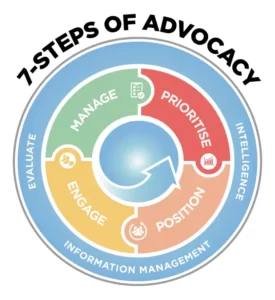
Step 5 of the 7-Step advocacy method concerns Engagement.
The first 4 steps of the 7-Step advocacy method have focused on preparation. When you engage with your stakeholders you translate all the data, analysis and outputs from your prioritization, intelligence gathering, stakeholder mapping, messaging and information management into engagement actions. In this blog we will outline the two main approaches to engage. In doing so we will try to answer: How can you make better engagement choices and build a balanced advocacy strategy that maximizes your chances of success?


Though our 7-Step method is presented sequentially, reality sees the steps unfold as continuous iterative processes. Continuous new data, new choices and new outputs (i.e. changing goals, stakeholders and messages) will all be available to, and required of, you.
You control your prioritization, intelligence gathering, stakeholder mapping, messaging and information management. It is a very different story when it comes to engagement and advocacy action. Defining your engagement strategy, choosing tools and measuring their impact is often a subjective choice. Ask three experienced public affairs practitioners which engagement actions they recommend for the same situation and you would likely get three (all very good) different recommendations. Experience and metrics play a big role in these choices.
In advocacy your goal is quite ‘simple’. You ‘simply’ need to convince (usually around) 25 key stakeholders to support and advance your position into legislation. In practice, your engagement strategy is likely to play out over 12 to 36 months. Your voice is likely only one amongst hundreds and you may only get to meet directly with, for example, five of your key stakeholders. So how, within this competitive maelstrom, can you ensure you achieve your advocacy goals and objectives?
Engage, which is Step 5 of the 7-Step advocacy method, can be broken into two parts:
- Direct Engagement:
- Indirect Engagement:
Collectively we refer to these two forms of engagement as your engagement footprint (i.e. the combination (or balance) of direct and indirect engagement).
We will look at each of them in turn.
Direct Engagement
Your engagement strategy should always include directly meeting the key officials, politicians and political aides (i.e. policy-makers) who are drafting, negotiating and adopting policy and/or law you are working on. This is direct engagement. Ideally those you meet have the most influence at that moment in time.
The theory of direct engagement is quite straightforward. If your organization has a legitimate interest and you have relevant information to share, you should be able to organize meetings with key policy-makers or their offices. Phone them, send an email, ask for a meeting. Make sure you clearly communicate ‘why’. Why should they meet with you? Is there a link with their constituency? Are they working on your issue? Does your issue relate to their political agenda? To succeed you should spend a good amount of time in these meetings with key policy-makers (see Step 3: Position for more details on stakeholder mapping). This is the easiest and most effective way to see your position translated into policy or law.
Direct engagement will help you build relationships (and potentially seal their support), identify areas for compromise or mark out areas of disagreement. Do your data, arguments and messaging have the legs to stand? Stakeholders give you live and direct feedback. They may challenge you and ask for proof points. If their body language is closed (i.e. if they look up at the ceiling, cross their arms, or spend the meeting working on their phone and not looking at you) your message is not getting through. Direct engagement is an iterative process, if the stakeholder sees your case as weak go back and reflect and adapt your case. No advocacy strategy is ever static. Remember that this feedback also tweaks your intelligence gathering, stakeholder mapping, messaging and must be included within your information management system.
To maximize your chance of success, consider how you prepare and perform. For example:
- Have you profiled your stakeholder?
- Do you know their past and current positions?
- Do you know their political role and networks?
- Is your data and message tailored to the stakeholder?
- Have you come equipped with, for example, position papers, infographics, amendments?
- Is your ‘ask’ already set out in terms they can use?
For successful direct lobbying we have the following recommendations:
- SKILLS: Skills are needed. Diplomatic and social skills are key to constructive interactions with policy-makers. Officials and politicians may switch sides due to real or imagined slights from undiplomatic encounters. A major taboo is to criticize other politicians or interests. Practitioners operate in small circles. You may be criticizing a colleague or friend.
- BAD MEETING: If you sense a meeting is going badly, close it down quickly. Make your apologies and leave.
- ARGUING: Never get baited into an argument, and if an argument gets out of hand, stop. Raised voices in meetings harms political interests.
- TRAINING: It is smart to put a colleague new to lobbying through a simulated meeting and see how they perform. Record the training and discuss their performance. Letting people out of the door to represent you unchecked or uncoached is high risk. Accompany them a few times to meetings to see how persuasive they are.
- LISTEN: Listening is a key (and sadly too often ignored) skill in advocacy. Listen to your stakeholders. Ask questions of them and give them the space and time to respond.
Finally it is worth considering who attends the meeting as this can make a real difference (for better or for worse). So;
- YOU: Are you the right person (level) for a specific meeting? Are you comfortable with the detail of what will be discussed? If the answer to these two questions is yes then it is possible you may take the meeting alone.
- EXPERT: Do you need to bring a technical expert to meetings? Experts answer questions rather than speak at length. They add weight to a solution and provide authority to support the case. Coach experts beforehand, notably on being concise and in using accessible language (plain English). Experts should see themselves as translators, turning technical subjects into easy (and quick) to understand issues for policy-makers.
- CEO: CEOs often delight in providing advice to officials. They can also be quick to take offence. Their travel schedule often means that arrive too late in the process. Their powers of persuasion tend to be weaker with policy-makers who don’t directly report to them so their intervention may raise more questions than it answers. There are some ‘rock star’ CEOs who people will change their schedule to meet, but they are a rare breed. If your CEO is one, use them. If not coach them.
For differing reasons, it may not be possible to achieve everything you want through direct engagement. In addition, alone it is rarely enough – you need to look at what other ways you will engage. We now turn to indirect engagement.
Indirect Engagement
Indirect engagement is essential to help support and add value to your direct engagement strategy. By engaging indirectly, you are able to increase the number of stakeholders (voices) that communicate your messages to policy-makers; a so-called echo chamber. You can also leverage relationships you don’t have, access people you can’t access and work through people and organizations with more credibility and influence with your key stakeholders. The main options for indirect engagement are through:
- Trade Associations
- Think Tanks
- Consultancies
- Coalitions and Alliances
- Influencers
- Academics and Technical Experts
- The Media
- (NGO) Supporters
- The General Public
It is all about balance and scale (as well as budget).
Each indirect strategy represents a significant investment of time and resources. Choose how to get your voice heard with great care. Decide how much time to spend managing your indirect strategy. It can amount to a full-time job and cost much more.
The key to successful indirect advocacy is a strong analysis of your position and message (steps 1-4 of the 7-Step method). The clearer your need, the easier it is to fill the gap. In conclusion we can provide the following suggestions to achieve a winning balance between direct and indirect strategies:
- Go Direct: Direct engagement is an absolute necessity. Make sure you meet your key stakeholders. Make sure you explain ‘why’ they should meet with you. Remember to test and review your messaging and data.
- Practice: Train and rehearse for your meetings and communications. Take time to simulate your meeting, especially with new colleagues or non-practitioners. Be diplomatic and learn to read non-verbal communication (body language). Get training.
- 2 not 1: Always consider who is best placed to attend a meeting or make a statement, public affairs practitioner, technical expert or CEO. Choose on the basis of the audience and their needs.
- Resources: Indirect strategies can be resource intensive. Choose your strategy and partners carefully. Consider all the tools in your toolkit. Adopt new tools. Don’t hesitate to negotiate the price for a 3rd party service. It’s a competitive market.
- Coalitions: Use your network and memberships to either plug any gaps in your reach. Consider when to delegate and when to reinforce.
- KPI: Always set clear KPIs for any organizations or partners you work with. You (and often they) need to understand what they will deliver on top of, or alongside, what you do
- Manage: Use our Communications Calendar Template to organize your internal and external, direct and indirect advocacy. Align these with your advocacy strategy timeline and the political process to deliver the right information, to the right person, with the right tool, at the right time.
Getting this balance right can be the difference between success and failure. Spend time making sure you know your engagement footprint as well as what you can and can’t deliver. More engagement doesn’t always translate to success. A compact well-thought-out direct and indirect strategy, with a careful selection of advocacy tools, can be incredibly effective if tailored and managed the right way.
Check out our Communications Calendar Template. Tailor the categories to your own strategy. Using an advocacy calendar empowers you to align your internal and external communications over time to ensure a sustained, feasible, cost-effective and measurable engagement strategy. In the final blogs of the series we’ll be exploring steps 6 & 7 (Manage and Evaluate) to clearly define their place in the 7-Step Method and also to identify the key knowledge, skills, tools, and deliverables contained within them. To further explore our 7-steps of advocacy method as well as our free advocacy tools, including our free advocacy assessment 7-step snapshot report, please visit: advocacystrategy.com.



